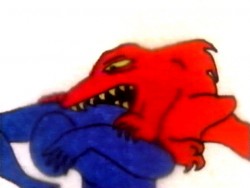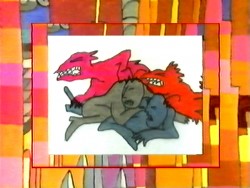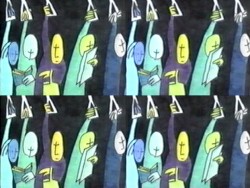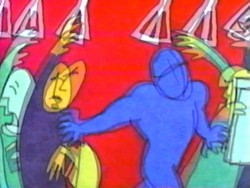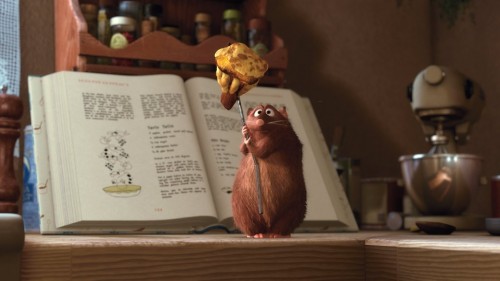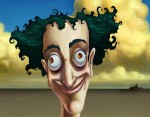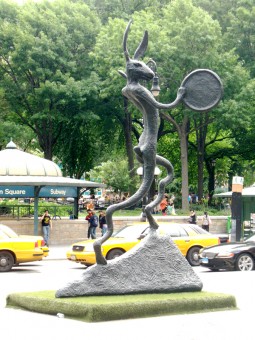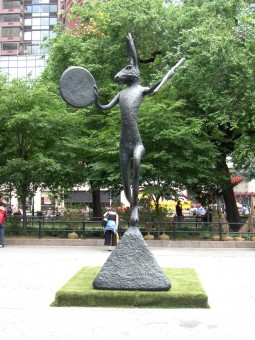Category ArchiveCommentary
Commentary 30 Jun 2007 09:34 am
I’m a Curmudgeon
- What can I say? I’m a curmudgeon. I didn’t totally love it.
Ratatouille (“rat-a-too-ee”), I mean. I had some predictable problems with the film.
Rats!
They fought the dogs and bit the cats. They ate the cheeses out of vats. Rats.
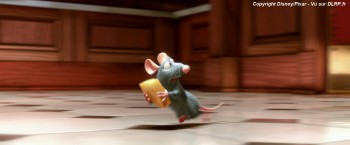 It’s hard to watch a movie, any movie that shows hundreds of realistic looking rats with realistic looking hair running across a restaurant kitchen. Or covering a small car. Or falling from a ceiling in a smallish house. It’s unpleasant. Is this the stuff of family film?
It’s hard to watch a movie, any movie that shows hundreds of realistic looking rats with realistic looking hair running across a restaurant kitchen. Or covering a small car. Or falling from a ceiling in a smallish house. It’s unpleasant. Is this the stuff of family film?
I wanted to give it four out of four stars, but I can’t – maybe three and a half. Pushing it. All those rats; they were just too realistic when you put a lot of them together. They got the look of wet fur just about perfect. The animation was almost realistic. (Some of it was actually nice character animation.)
The kids in the theater. I heard all three of them – it was a private screening – ask what was happening. They seemed to have a bit of trouble following it. Maybe kids aren’t supposed to enjoy every “family” film. I don’t know.
Then about 3/4 of the way through the film, there’s a real slowdown, and I had to look at my watch to see what time it was. Like every other Pixar film, it was five or ten minutes too long.
I’m sorry. I’m a curmudgeon. Maybe I should tell you what I liked about the film.
Let’s try to forget that we’re talking about RATS RUNNING AROUND KITCHENS!
The craft in constructing the film was top notch excellent. I mean some of the character animation was exactly that – excellent. Not all of it, but enough of it. All of it was, at least very good. Peter O’Toole gave them the one great voice in the film, and the animators responded brilliantly. His character seems a refugee from a Tim Burton film.
The Backgrounds were stylized and looked illustrated. In fact, they were often very attractive. I wish they were a bit more stylized, but that’s just my own personal bias kicking in. In CARS you had an attempt to imitate real, and I didn’t get the point.
Ratatouille had an intelligent approach to the audience. None of those media references animated features always throw at us to tell us how with it they are. (This has been part of the landscape ever since Aladdin, and Jeffrey Katzenberg seems to encourage it.) That’s an enormous plus – treating an animated film with some dignity.
So there you have it. The body of a really good film with a lot of RATS RUNNING AROUND KITCHENS! Sorry, I can’t get over it, and I don’t think I should.
The end credits featured 2D animated rats in kitchens, and there was more of a remove. These didn’t look like real rats, and I realized that probably would have been the way to save the day – 2D animation. Rats are just such a bad idea for lovable animated characters, and there’s such a penchant for animators – cg animators – to feature them these days.
Walt Disney never would have allowed it during his life. He had a MOUSE, and he stood him up, put him in shorts and treated him as if he were human. Even the mice in Cinderella wore clothes – for a reason. They were mice – these are RATS.
I debated keeping this opinion to myself, since I know you’re all going to hate me now, but what can I say. It’s what I felt while watching the film; it’s what I think a lot of adults are going to feel while watching it. I hope Pixar makes a ton of money with it, but in the end I don’t expect it to go through the roof – after the first weekend. I hope I’m wrong. I think Brad Bird is brilliant, but there were rats running around kitchens here.
- Some articles about the potential box office are worth viewing.
#1 here, #2 here. Of course, all predictions are already probably moot since the opening box office is already in (around $16.5 million for Friday) and predicted to be a close #1 against the new Die Hard film. Fun to speculate though.
Commentary &SpornFilms 28 Jun 2007 08:01 am
Monthly Abstractions
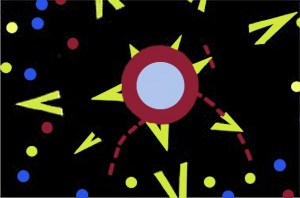 - Jeff Scher is back in the opinion pages of the New York Times with his monthly animated contribution. The piece, this month, celebrates the Fourth of July with a confetti confection of fireworks. The short film takes its cue from Oskar Fischinger.
- Jeff Scher is back in the opinion pages of the New York Times with his monthly animated contribution. The piece, this month, celebrates the Fourth of July with a confetti confection of fireworks. The short film takes its cue from Oskar Fischinger.
The piece is designed for the TimeSelect subscribers, so it may be hard for some of you to receive it. Give it a try.
It’s an interesting gig to have to deliver an animated piece each month for the internet. Jeff’s last and initial piece is still available on line, as well. Here’s L’Eau Life. If you haven’t seen that film, check it out.
Speaking of Oskar Fischinger, I’ve linked to the Fischinger Archives. Oskar, you should know, was an important abstract animator whose most famous piece was the Toccata and Fugue in Fantasia. The archives have galleries of some of Oskar Fischinger‘s animation drawings: 2, or 3.
Above is an Oskar Fischinger silent film, “Seelische Konstruktionen,” which was set and reworked to a musical number, Cavern, by the rock group Liquid Liquid.
Richard McGuire was the bass player of the group; he’s now directing animation at Prima Linea Productions in France. He’s done a lot of work for the NYTimes Sunday Book Review and the New Yorker magazine. He’s credited for reworking Fischinger’s film to tie into the group’s song.
I did an animated video of the song in 1983, just as the group broke up. I got it onto ABC’s late night music video program at the time and a couple of local shows. The record company, 99 Records owned and operated by Ed Bahlman, went out of business not too much later. The film was screened in competition in Ottawa.
Here are some frame grabs from the video I animated. I used multiple split screens and violent cutting to make a short about the small everyday bits of violence we saw on city streets.
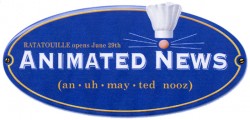
- By the way, on a completely different topic, I love the temporary logo on at Animated News. It reads, under the title banner: (an-uh-may-ted nooz). Hilarious stuff.
The logo links to the Pixar Ratatouille site.
Books &Commentary 27 Jun 2007 07:49 am
NIMH, Bart, Ghibli & other feature thoughts
- First up, in case you haven’t seen this letter, I suggest you check it out. A rejection letter from the Disney studios, 1938.
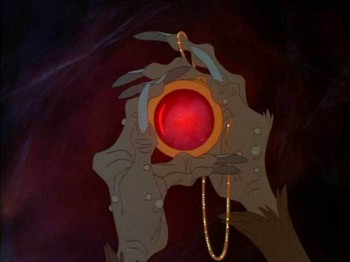 – Monday night The Secret of NIMH aired on cable television. Somehow, even though I own copies of this film on dvd and video, I hadn’t seen it since it opened in theaters. Watching it again, after all these years, I found that not much had changed. 25 years didn’t hurt or help.
– Monday night The Secret of NIMH aired on cable television. Somehow, even though I own copies of this film on dvd and video, I hadn’t seen it since it opened in theaters. Watching it again, after all these years, I found that not much had changed. 25 years didn’t hurt or help.
I have to admit that I was kinder to it for the nostalgia of the piece. The wave of enthusiasm I felt for the “renegades,” who pulled the film together despite the odds of the period working against them, was high.
The film still has that mediocre ending. It’s such a romantic conclusion that it’s almost difficult to watch; magic overcomes everything in this world of Bluth.
Also, I’ve never quite understood the eyes of anyone in the film who’s supposed to be old (and I guess wise) – they just glow so there’re really no eyes there. Somehow the gimmick is corny.
At times the film is so densely colored, but then at other times it’s flat. This flips back and forth from scene to scene. However, this I forgive for a film that was obviously done for a low budget and with a lot of heart.
That Jerry Goldsmith score almost makes the film and all its negatives brilliant. And the voice of Elizabeth Hartman as Mrs. B(F)risby is inspired. It’s quite unique and quirky. This is one of her best performances, and she had many of them.
In the end, I’m glad to have watched it again, but it’s unlikely I’ll rush to view it again in the next few weeks.
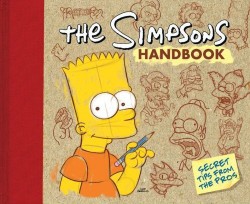 – The NYPost printed a big illustrated review of The Simpson’s Handbook, a new book designed to show you how to draw the characters of The Simpsons. The credited author is Matt Groening.
– The NYPost printed a big illustrated review of The Simpson’s Handbook, a new book designed to show you how to draw the characters of The Simpsons. The credited author is Matt Groening.
The book appears to print model sheets reworked for the general public. Otherwise it seems to be somewhat similar to those Disney How to draw Mickey (or Donald or Goofy or Pluto) books you could get at Disneyland in the 60′s.
The on-line version of the review doesn’t include all those that appeared in the newspaper; some of the illustrations from the book were printed. The images looked interesting though the Post tried to make it look like a fun-for-kids book. I’ll have to check it out when I’m in a book store.
I guess they’re starting to gear up the publicity machine behind the Simpsons feature film about to be released.
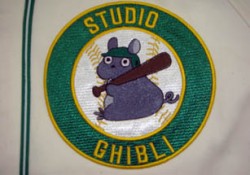 – Daniel Thomas MacInnes hosts an excellent site called Conversations on Ghibli. There, naturally, you’ll find an enormous amount of information on Ghibli, the studio that hosts Miyazaki and his films.
– Daniel Thomas MacInnes hosts an excellent site called Conversations on Ghibli. There, naturally, you’ll find an enormous amount of information on Ghibli, the studio that hosts Miyazaki and his films.
Not only does Daniel Thomas offer extensive current information about the films, but he also posts many, many videos.
Currently there are a number of short films to view on the site. Go there and just start watching.
Three I found breathtaking are:
……..a Yurij Norstein ad: here
……..Miyazaji’s Sky Colored Seed: here
……..Yoshiyuki Momose’s ads for House Foods: here
For those of you who haven’t seen this insurance ad by Sylvain Chomet, maybe it’ll help keep you on hold until his next film appears. It’s already been four years since The Triplettes of Belleville. Making features is a tough business.
- I assume many of you have read Jim Hill‘s article on the potential box office draw for Ratoutille (Rat-a-too-ee). The article sounds like good business sense even if it isn’t the tale we’d all like to hear. I assume we’ll all know the answer by this time next week.
Rants against this article appear at Tom Sito‘s site and at the Animation Guild Blog and at Josh Tyler’s Cinema Blend.
Michael Barrier has a positive review of the film worth reading.
Commentary &SpornFilms 19 Jun 2007 08:00 am
Show and Tell
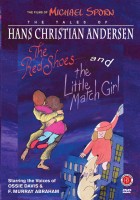
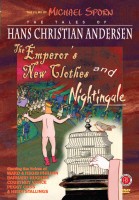 – Tomorrow, Wednesday, ASIFA East will have a program built around the two dvds we have in release this coming week.
– Tomorrow, Wednesday, ASIFA East will have a program built around the two dvds we have in release this coming week.
We’ll show clips from the four films featured on the dvds as well as a bit of the documentaries made for the discs. Masako Kanayama, Jason McDonald, Ray Kosarin and Stephen MacQuignon, all of whom were among those who helped make the films, will join me on the the stage to talk about the energetic little studio we had at the time that made the films in a very short period.
We’ll view the art styles that went into making the shorts and the various techniques we used in the making. I’ll bring some of the art to demonstrate.
If you’re in the New York area, I encourage you to join us for the evening. It’s free.
School Of Visual Arts
209 East 23rd Street
(Bet. 2nd & 3rd Ave)
5th Fl, Rm 502
7 PM
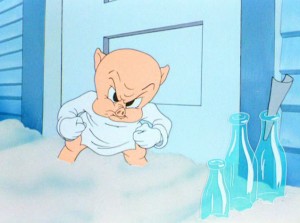 A post I enjoyed this last week appeared on Eddie Fitzgerald‘s Uncle Eddie’s Theory Corner.
A post I enjoyed this last week appeared on Eddie Fitzgerald‘s Uncle Eddie’s Theory Corner.
The thesis Eddie presented is that inbetweens should be more integral to the animated extremes than mere inbetweens. Exact inbetweens of an animator’s work is essentially artless. A close breakdown of a great example, Rod Scribner‘s scene from Bob Clampett‘s Porky Pig short, Kitty Cornered, is given.
The problems occur (as many of those who commented on Eddie’s site stated) when an inbetweener – generally someone relatively new to the profession – is given free reign on an animator’s scene.
At Raggedy Ann, where I supervised NY’s assistants and inbetweeners, we had one novice erase Jack Schnerk’s roughs because she didn’t like the way they looked. The she repaired them and started inbetweening. Fortunately, we were able to reconstruct Jack’s scene and have the scene re-inbetweened.
At Fleischer’s studio in the thirties, for the first weeks of the job, inbetweeners were made to draw exact halves between two lines. Over and over and over and over and over.
Rod Scribner obviously had similar working methods that I was taught by Tissa David. Both qualify as straight-ahead animators. (This was initially the reasoning given for the rift between Ub Iwerks and Walt Disney that ultimately led to their early split.)
For those who don’t quite understand what I’m talking about, an Inbetweener by definition is hired to put missing drawings between two extreme drawings. An animator does drawings #1 & #5. The inbetweener draws #3, then inbetweens #2 and #4. A straight ahead animator would start with drawing #1 then continue forward until completion.
In fact, David and probably Scribner are more an amalgam of straight-ahead AND inbetween.
Tissa hates leaving drawings for an inbetween unless the process is forced on her or there is just too little time. However, working straight-ahead allows strange things to happen to the characters you’re animating. Going from drawing #1 to #2 to #3 etc. the drawings will subtly shift in shape until you can end with something very different by the time you reach the final drawing. Tissa tells the story of a dance scene where the character grew almost twice in size by the time she finished it. She then had to go back and redraw the entire scene, correctly sizing it.
She does very rough roughs for herself blocking the scene, leaving a large number of inbetweens. She then goes back and reworks the entire scene of completely new drawings (not clean-ups of her roughs) working straight-ahead UNLESS there are obviously mechanical inbetweens required. Then she’ll go back to do those inbetweens herself or hand them down to an assistant if available.
I assume Rod Scribner used a similar method. The drawings are too tight, especially the extremes for them to be otherwise. I wonder if there is a way to get inbetweeners to do the special inbetweens that Eddie longs for?
Certainly, they couldn’t be neophytes to animation, but would it make sense for anything less than an excellent assistant?
In my studio, I’ve tried to allow animators to work the way they like. They can work from the loosest of materials (sometimes just the rough storyboards we do) or the most exact of layout. I love it when animators do their own inbetweens, but some of my best animators over the years have required an assistant and an inbetweener. Doug Compton did some brilliant work with enormous vitality, and he definitely works with an inbetweener or five. John Dilworth, on my films, did some of the finest, most insightful character animation drawing his own inbetweens. Both of these guys are, now, excellent directors in their own right, both have similar but different methods of animation.
Eddie Fizgerald ‘s post has been quite thought provoking for me; I encourage you to take a look. Seeing the inbetween poses of that Porky scene is quite revealing. I may continue this with examples of my own. I know, for example, that Jim Tyer left inbetweens but it sure looks like he didn’t. Both Tyer and Scribner often did a more extreme kind of movement. I’m interested in the animators that worked a bit more quietly and did more interesting and expressive inbetweens themselves.
Books &Commentary 18 Jun 2007 07:43 am
The Animated Man
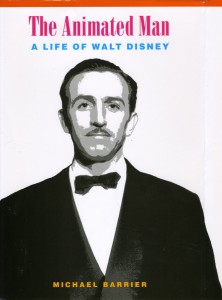 – Michael Barrier‘s The Animated Man: A Life of Walt Disney is unlike any other Disney biography I’ve read. (Since I think I’ve read about 90% of them, that’s quite a statement for me.)
– Michael Barrier‘s The Animated Man: A Life of Walt Disney is unlike any other Disney biography I’ve read. (Since I think I’ve read about 90% of them, that’s quite a statement for me.)
On my initial reading of the first half, I was ready to proclaim the book one of the finest animation books ever written. All the information on Disney’s developing studio in the 20’s, the backstabbing, deal making, and filmmaking was so well organized, detailed and well developed in the book that it was crystal clear where, why and how Disney was pushing his organization to a larger state. Where else have we read that the Disney brothers were HAPPY when Ub Iwerks left?
The story gets even more intense as Snow White grew to completion. We learn about the budget developments, the artistic growth within the studio and the push to meet the final screening. Where else have we read that the final bank loan from BankAmerica wasn’t a make or break it deal, that the studio would NOT go bankrupt if they didn’t get it. And they knew in advance that they were going to get it!
Walt Disney seems to get somewhat confused after the successful opening of Snow White and the large amounts of money that came back to the studio. Prior to this, I had always thought Pinocchio, Bambi et al were well into production as Snow White came to an end, so that there was a smooth transition from the first feature into the line-up of others. But, no. There was a lot of confusion within the studio as productions got switched and development turns from one to another.
Apparently Disney was a restless guy. A revealing comparison between Walt and his father is made, a man who seemed to go from one career to another so wildly in those early years that, prior to this book, I often wondered if everyone was like that at the turn of the 20th Century. I came to realize that these two guys had much in common and were unlike many others of their time.
In many ways it reminds me of something in the Ub Iwerks biography, The Hand Behind the Mouse, by John Kenworthy & Linda Iwerks. That book states that Iwerks felt that once he mastered something, he moved on. He bowled obsessively until he hit a perfect score, 300; then he never bowled again. In some ways it seems as if this were also true of Walt Disney. Once he did something, he moved onto something bigger and more challenging.
The restlessness shows in Disney’s split interest in the features that immediately followed Snow White. The attempts to make money had them thinking about live action from the  earliest days. I don’t think anyone has written before about this atmosphere from Disney’s point of view.
earliest days. I don’t think anyone has written before about this atmosphere from Disney’s point of view.
The book goes from the Strike to the War to Live Action. Slowly the interest in animation wanes, and the book puts its attention on the aspects of Disney’s world that HE was interested in. When his all-consuming passion shifts away from animation to live action, to the theme parks, to city construction and planning, the book follows this, almost exclusively.
(Images from the book enlarge when clicked.)
This is where it becomes less an animation book – possibly the best animation writing done on Disney, it’s so informative – to the Biography we expected. However, there’s as much detail about Disneyland or EPCOT from Disney’s point of view as there was about animation.
It’s so thoroughly researched that you feel confident that the picture you’re reading is undoubtedly accurate.
For the first half of this book, this is an animator’s version of Disney. The biography we always wanted. When Disney loses interest in animation, the book seems to shift as well, and it should. The true-life adventure films, for example, get more attention than Lady
and the Tramp, which is barely mentioned. In a biography of Disney this is probably appropriate, but as an animation die-hard this is my interest, and consequently the problems with the book, for the most part, are my fault. I got so much about animation at the beginning that I hoped for more later on.
I also wanted more about some of the personal aspects of Disney’s life. I expected, for example, to read more about the death of Disney’s mother; it seems so briefly tossed out in one paragraph I was struck, surprised, at how little attention was given to her accidental death. Disney must have felt guilt over her death when the new home built by the two sons had a faulty gas tank, and she died of asphyxiation, yet so little about it is explored (with a footnote advising us to go to a Bob Thomas book if we’re looking for more detail.)
This made me assume, once I hit this point, that the book was more interested in Disney the entrepreneur/businessman than in Disney the son/husband/father. The private side of Disney, I understand, was less about his personal side than his work. No vacation went without work, no lunch or private conference on the polo field went without discussion of Disney’s interest. The man didn’t have much of a personal life, so I understand the choice.
The focus stays firmly fixed on Walt Disney, the artist. It’s a unique read and one I’ll undoubtedly reread. There’s so much material and so much of it original research and commentary that, oddly, one almost wants more.
The book presents a man who helped to shape the first half of the 20th Century. It wasn’t just in his animation or his live action or his theme park development. It was in all of them, the man who was behind them all. The book offers this man with all of his pluses and minuses with hard-nosed information rather than stories, conjecture or rumor.
Barrier is a treasure among animation writers. His facts are indisputable, his information so all-enveloping, his toughts well-honed and at the top of the game. He’s written an excellent book; one that absolutely engrossed me and, at the same time, challenged me. I recommend it wholeheartedly (in case you couldn’t tell.) With half the number of pages of Neal Gabler‘s recent book, Michael Barrier gives us so much more.
Commentary &Photos 17 Jun 2007 08:04 am
Lil’ Fair – Photo Sunday
- Maybe twice a year, Carmine Street, which is half a block from my studio, hosts a small street fair which works its way off onto Bleecker Street, another block away. Yesterday, was one of those days.
Throughout the summer, these street fairs are the norm and they move all over the city from weekend to weekend. In this local one, the merchants on both streets also join the cavalcade of professional street fair folk who travel from fair to fair.
 1
1 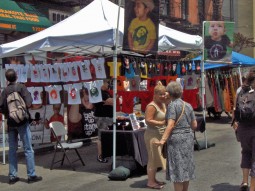 2
2
1. From my studio, this is the view you get looking down Carmine Street toward Bleecker and 6th Avenue.
2. What would a street fair be without a T-Shirt vendor. Just bring your photo.
 3
3  4
4
3. As you move down the center of the street, you get to see the wares a little better.
4. A local restaurant has a selection of bottled herbs for sale.
 5
5The fair always offers interesting ethnic food. This little tent offers Thai food.
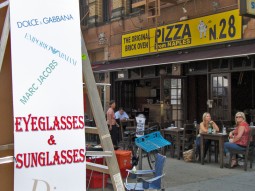 6
6  7
7
6.Here a local vendor offers a wide variety of sunglasses. The sidewalk restaurants have their outdoor tables in full use.
7. Around the corner onto Bleecker Street more of the generic vendors take charge selling their gyros, fries and other foods (all tasty but none good for you.)
 8
8This vendor has probably the best spot right on the corner of Carmine & Bleecker.
This very stand seems to be the anchor for every street fair you can get to over
the entire summer. And that includes the San Gennaro & St. Anthony feasts.
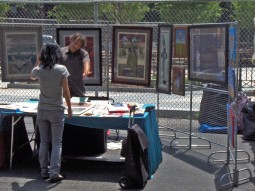 11
11
11. Even art (of a sort) is for sale.
12. Even better is fresh fruit packaged artfully.
 13
13At the entrance (or exit depending on which way you’ve come)
there’s a sign closing off traffic.
At exactly 5PM a thunderous storm hit the Village. Rain came down very hard and ran in buckets. Within 20 minutes, however, it was gone, and the sun was back out. The vendors at the Lil’ Fair must’ve known this, because they quickly covered their merchandise with blue plastic baggies, and waited out the short storm. By 5:30, they were open for business again albeit a little bit wet.
Commentary 16 Jun 2007 08:49 am
Awaiting Moderation
 – Last night’s Yankee game found the team that couldn’t hit mediocre pitching had returned to the Bronx, so the game was a bit dull. Since I had gone to a screening on Thursday to see the new Nancy Drew film – a perfectly non-existent entity that tries to be retro, tries to be au courant and ends up being nothing but an attraction for 12 year old girls who probably won’t flock to the theater to see it – I had to keep switching over to TCM to see the series of Nancy Drew films done in the 40′s. They were “B” films that didn’t try to be much and probably ended up being a bit better than the current “A” film that isn’t much.
– Last night’s Yankee game found the team that couldn’t hit mediocre pitching had returned to the Bronx, so the game was a bit dull. Since I had gone to a screening on Thursday to see the new Nancy Drew film – a perfectly non-existent entity that tries to be retro, tries to be au courant and ends up being nothing but an attraction for 12 year old girls who probably won’t flock to the theater to see it – I had to keep switching over to TCM to see the series of Nancy Drew films done in the 40′s. They were “B” films that didn’t try to be much and probably ended up being a bit better than the current “A” film that isn’t much.
However, the features hadn’t yet started on TCM, and they were filling the airtime with a Barney Bear short, The Flying Bear. I came into it just after it had started, hadn’t seen it in at least 20 years, so was thoroughly charmed by the remainder of the short.
I was always a fan of the Ising cartoons, and Barney Bear is probably the closest he came to a running character. The films he made were filled with high production values, excellent animation, artwork and layout. The music of Scott Bradley was probably at its zenith, and the color was just gorgeous.
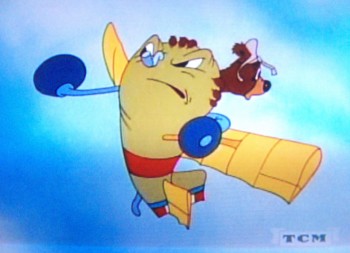 I didn’t like the films once they slipped into the hands of George Gordon, and really didn’t like them when Michael Lah, Preston Blair and Dick Lundy were in control. That group tried to incorporate Tex Avery into Ising‘s personality, and it just didn’t work.
I didn’t like the films once they slipped into the hands of George Gordon, and really didn’t like them when Michael Lah, Preston Blair and Dick Lundy were in control. That group tried to incorporate Tex Avery into Ising‘s personality, and it just didn’t work.
Anyway, watching this MGM short had me thinking about a couple of other sites I’d visited this week.
.
Kevin Langley‘s Goober Sleave has been featuring the MGM shorts for quite some time. He posted a number of model sheets of Barney Bear and it seemed appropriate that I should run into one of the shorts after having just looked at these model sheets again.
Watching the fine character animation of the plane in The Flying Bear had me thinking about other MGM shorts and the house style in the late 30′s – early 40′s and how much I enjoyed those. I’d thought about it a bit earlier in the week when I came upon Thad Komorowski‘s excellent post about the rampant racism in Tom & Jerry cartoons.
I’d seen only one or two T&J shorts at the Museum of Modern Art prior to their appearance on syndicated television back in the late 60′s. When they’d first arrived on TV some of the racist images were eliminated but enough stayed to be annoying. More irritating to me however was the violence in these shorts. Somehow, when T&J cut each other with knives and forks and any other possible sharp object, they HURT each other. It wasn’t like the violence in the Avery shorts or the WB shorts; Tom & Jerry really hurt. I remember vividly watching one of the shorts where they’re running down a well dressed table full of turkey etc., and Tom is cut with a knife. The audience at MOMA didn’t laugh; they gasped.
The scene wasn’t funny; it was vicious.
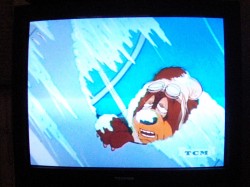 I always had to love the exquisite artwork, animation, BG’s etc. from these films, but Hanna & Barbera’s direction was not for me. I hated their work at MGM. I don’t think I can say that about any others working back then. There were a lot of bad films, but none that I thought so completely insensitive to violence, racism, or anything funny. Perhaps it’s just me, but I don’t think so.
I always had to love the exquisite artwork, animation, BG’s etc. from these films, but Hanna & Barbera’s direction was not for me. I hated their work at MGM. I don’t think I can say that about any others working back then. There were a lot of bad films, but none that I thought so completely insensitive to violence, racism, or anything funny. Perhaps it’s just me, but I don’t think so.
As Thad points out on his site, the racism in these films can’t be excused for the time or place thing that might excuse racist images in Bob Clampett‘s shorts or Tex Avery‘s or even Song of the South. Hanna and Barbera were mean; at least that’s what I perceived from their body of work at MGM.
When the old Nancy Drew came on, it was about as dull as the new one, but the period “B” movie feel brought something positive to the experience. The Yankees lost, as was expected, but the Barney Bear short lingered.
Another site worth reading is the ever excellent Mark Mayerson. His series, Six Authors In Search of a Character is enormously bright and thought provoking. He’s up to part 9, and I rush daily for more.
Commentary 14 Jun 2007 08:53 am
Rats, Skulls & Lil’ Bushes
 – The dining section of yesterday’s NYTimes included an extensive article about Ratatouille (pronounced Rat-a-too-ee).
– The dining section of yesterday’s NYTimes included an extensive article about Ratatouille (pronounced Rat-a-too-ee).
The Disney studio understands well the art of exploiting publicity in all the sections of the Times.
(I have to assume that similar articles appeared in many newspapers across the country.) Next week there’ll be an article in the Science section on how to construct a cg rat. Let’s hope the film will be as tasty as expected.
– There’s an on-line interview with John Dilworth about his film Life In Transition on Quinn Strassel‘s On Stage. It’s short and lite.
_______________________________
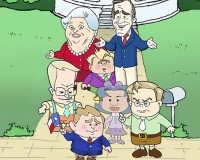 – Thumbs down for Lil’ Bush the new animated series that premiered on Comedy Central last night. Why would anyone think that the country would get any pleasure watching an animated version of the idiot in the White House? It’s hard enough living through these next two years, now we have to put up with an animated reminder of the endless nonsense we’ve been dealt from these Washington thugs. As if that’s a good excuse for humor; I’m living it. I don’t think I’ll be tuning in.
– Thumbs down for Lil’ Bush the new animated series that premiered on Comedy Central last night. Why would anyone think that the country would get any pleasure watching an animated version of the idiot in the White House? It’s hard enough living through these next two years, now we have to put up with an animated reminder of the endless nonsense we’ve been dealt from these Washington thugs. As if that’s a good excuse for humor; I’m living it. I don’t think I’ll be tuning in.
Two local reviews were more than a lil’ bit negative. Here’s The Daily News review.
The NYTimes review by Mike Hale concludes:
- Tonight’s installment of this pioneering cellphone-to-television transfer appears to prove that some things are, in fact, too small even for TV. What looked crude and amusing on a phone — or on YouTube, where the first mobisode has drawn a middling 462,000 views since it was posted nine months ago — simply looks crude on the medium-size screen, despite the improved animation.
My first question is: what’s a “mobisode”? That seems to be what they’re calling them in all press releases.
Here’s a video interview with Donick Cary the “creator” of the show.
Credits issued in the Comedy Central press release are as follows:
- “Lil’ Bush” comes from creator and executive producer Donick Cary, (“The Simpsons,” “The Late Show with David Letterman”) and co-executive producer, Jay Karas. Seth Cummings and Peter Adderton from Amp’d Mobile also serve as executive producers, while Zoe Friedman and David Koga are the executives in charge of production at COMEDY CENTRAL. Animation is being done by Sugarshack Animation.
Lots of exec producers, not so many animators on the list. Pretty pathetic even if it was expected.
______________________ _______________________________
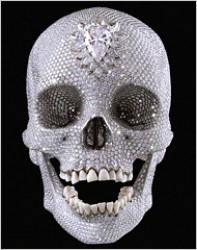 Speaking of yesterday’s news, there was an article in yesterday’s NYTimes about the $100 million sale of the jewel encrusted human skull created by artist, Damien Hirst. It took no time for Mr. Hirst to comment that the diamonds in the skull “are all ethically sourced, each with written guarantees in compliance with United Nations resolutions.†The diamonds were “conflict-free.†I guess for $100 million that’s the least I might’ve expected.
Speaking of yesterday’s news, there was an article in yesterday’s NYTimes about the $100 million sale of the jewel encrusted human skull created by artist, Damien Hirst. It took no time for Mr. Hirst to comment that the diamonds in the skull “are all ethically sourced, each with written guarantees in compliance with United Nations resolutions.†The diamonds were “conflict-free.†I guess for $100 million that’s the least I might’ve expected.
Damien Hirst was one of the artists that Rudolph Giuliani tried to have censored in 2001 when an exhibit that included Hirst’s cow under glass and Chris Offili‘s Virgin Mary painted with elephant dung opened at the Brooklyn Museum. This occasion drew thousands of protestors – mostly against Giuliani – to the Museum, and it made me more aware of the two artists. Now it seems that Hirst has taken his art to a new plateau.
The arrogant attempt by Giuliani to shut the show at the Museum was just one of his many attempts at violating the rights of the citizens of NY. Perhaps he’s the real Lil’ Bush.
The article in the Times is a good read.
______________________ _______________________________
Mark Mayerson has been posting an excellent series of articles entitled Six Authors in Search of a Character. He’s up to Part 9, and he is writing something very rich for animation commentary. I’ve been saving this material in printed form, and someday I hope Mark will locate a publisher for it. Take the time to read it all.
Art Art &Commentary 10 Jun 2007 10:21 am
Two Statues
- One thing about New York is that there are a lot of statues. Lots of parks filled with lots of statues of late Presidents, generals, soldiers. As we saw in Balto, there’s even a statue of a dog that saved some lives. Not too long ago I posted some steel silver statues of trees as they grew in Madison Square Park. I have a fascination with a lot of the old guy statues that also fill up that park and how they’re all staring at the center – those steel trees.
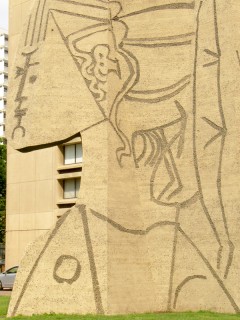 But I thought I’d post some pictures of two statues that fascinate me. One that I see almost daily since moving to the village is the big Picasso statue that graces NYU’s apartment complex on Bleecker Street. Unlike the massive Picasso statue in the center of Chicago, this one is not made of metal. It’s stone. Oddly it almost looks like a statue that was made by an admirer of Picasso’s – it’s almost too Picasso-like. But there’s a lot I like about it.
But I thought I’d post some pictures of two statues that fascinate me. One that I see almost daily since moving to the village is the big Picasso statue that graces NYU’s apartment complex on Bleecker Street. Unlike the massive Picasso statue in the center of Chicago, this one is not made of metal. It’s stone. Oddly it almost looks like a statue that was made by an admirer of Picasso’s – it’s almost too Picasso-like. But there’s a lot I like about it.
I like how it almost exploits the cubist thing as you walk around the statue the size and shape of the head changes. Angles are everything with this lady. As you move around her things keep changing. It makes me curious to know what it looks like from above (like from the roof of the building behind it.)
The color seems designed to almost perfectly match the buildings that stand around it. (Or maybe the buildings were designed to match the statue.) The engraved lines that shape her face use the shadows they create to make them lighter or darker depending on the overhead light.
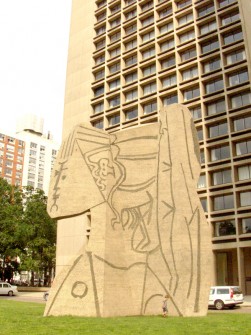
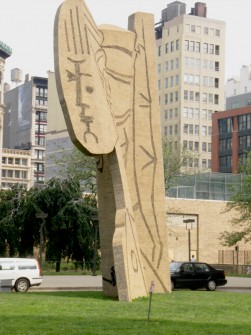
Look how her chin looks completely different as you move around her. The same is true
of the entire statue.
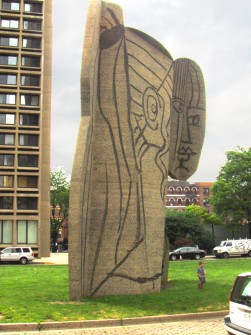
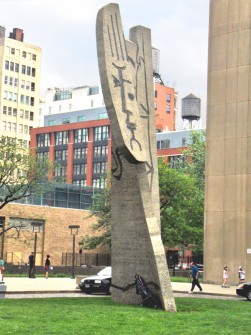
As you turn from back to front the whole statue looks completely different. It’s a great piece.
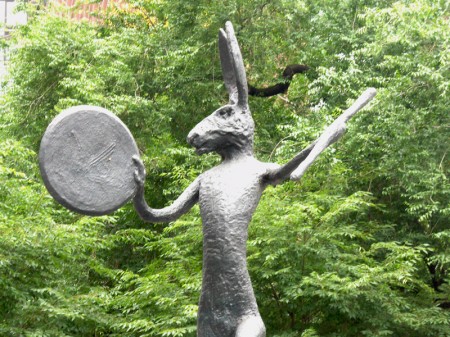
.
Then there’s the rabbit. This piece stands on a small traffic island at the base of Park 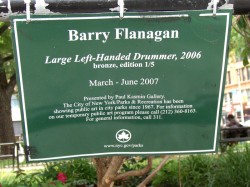 Avenue as it reaches 14th Street. The statue stands at one of the entrances to Union Square Park. If you’re heading to the Farmer’s Market situated within this park, it’s likely you’ll pass this statue.
Avenue as it reaches 14th Street. The statue stands at one of the entrances to Union Square Park. If you’re heading to the Farmer’s Market situated within this park, it’s likely you’ll pass this statue.
The statue is by Barry Flanagan. Apparently he did five of these rabbits (though I haven’t seen any of the others.)
He’s an Irish artist who has done quite a few sculptures of rabbits and other animals. He died in 2005.
(Click on any image to enlarge.)
There’s just such a wide diversity of public art on display; it always stirs me.
What a creative place to live.
Commentary &Daily post 08 Jun 2007 08:04 am
More Talking Animals
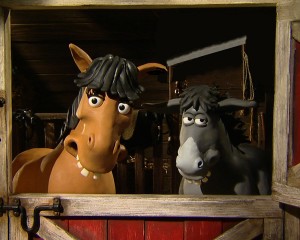 – This past Monday, CBS premiered Aardman Animation‘s Americanized version of Creature Comforts. Interesting that I didn’t see much on the animation sites about its premiere. The show will air at 8pm until CBS starts playing with their schedule. (Isn’t this what always happens these days?)
– This past Monday, CBS premiered Aardman Animation‘s Americanized version of Creature Comforts. Interesting that I didn’t see much on the animation sites about its premiere. The show will air at 8pm until CBS starts playing with their schedule. (Isn’t this what always happens these days?)
Fox also premiered the third-season of reality show Hell’s Kitchen at the same time. With plenty of promotion, this was the top-rated show Monday night among adults 18 to 49 with a 3.6 rating in the preliminary Nielsen ratings.
Creature Comforts had a modest 1.8 premiere in its 8 p.m. time period. That made it 2nd in the time slot.
Richard Goleszowski acts as the show’s supervising director. He also supervised the UK version of the show. Like all other Aardman work, the timing is just about perfect, the humor is subtle, and the whole is enjoyable. The only problem I have with the show is that I get impatient with a half-hour of 1 or 2 minutes clips that are disconnected.
You can watch the entire first episode on line. here.
- In case you haven’t yet read it, Wade Sampson has a good article on MousePlanet that fills in on a lot of the history of the Three Little Pigs. The article ends with a discussion of a four minute film done in 1962 by Bill Justice and Xavier Atencio for a Mexican feature as a way of raising money to help Mexican children get a free daily lunch in school. The article also leads to a YouTube link to see the animated segment they produced.
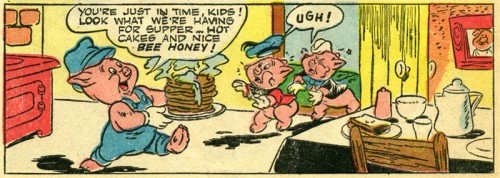 ___________________________________
___________________________________ 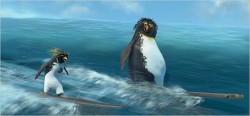 Surf’s Up opened today to luke warm reviews in NYC. Here are bits from two of them.
Surf’s Up opened today to luke warm reviews in NYC. Here are bits from two of them.
Jack Matthews of the NYDaily News, who gave it 2½ stars, said:
- Tired of penguins yet?
“Surf’s Up,” the latest computer-animated cartoon from Sony Pictures Animation, takes the form of a mock documentary covering a penguin-dominated surfing championship. The movie itself is trying to catch a wave; whether that wave is still cresting or about to collapse, we’ll soon find out.
Adult fans of “Happy Feet” will find “Surf’s Up” a middling trifle.
Jeanette Catsoulis of the NYTimes, in a very short, ho-hum review, wrote:
- Ever since Luc Jacquet’s endearing documentary “March of the Penguins” persuaded Hollywood that penguins are the new Bambis, we have endured singing, wisecracking and even tap-dancing versions. Now, treading eagerly on the flippers of last year’s “Happy Feet,” comes “Surf’s Up,” a computer-animated comedy featuring birds on boards.
. . . a moratorium on penguins might be called for, despite the inevitable anthropomorphic void. Lord help us if “Ratatouille” is a hit.
I’d like to highlight two working Independent animators in New York who have mastered Flash and have been doing unique, stylish films in the medium:
- Xeth Feinberg has created a character I’ve loved (it was probably the first Flash film I’d 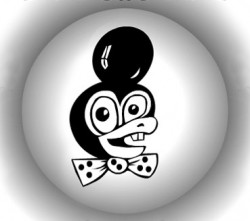 seen on-line). Certainly most of you have seen Bulbo in A Brief History of the Twentieth Century. This and a number of other Bulbo spots are still available for viewing at Xeths’ site. It’s worth revisiting to see how solid a video this is. Still thoroughly enjoyable.
seen on-line). Certainly most of you have seen Bulbo in A Brief History of the Twentieth Century. This and a number of other Bulbo spots are still available for viewing at Xeths’ site. It’s worth revisiting to see how solid a video this is. Still thoroughly enjoyable.
Xeth has done a feature film with his more popular character, Queer Duck, but I still feel more of an affinity toward Bulbo. Perhaps he’ll make more of these entertaining short pieces.
- And let’s not forget Nina Paley, as long as we’re talking productive, Flash designer/animators. Nina’s done quite a few animated shorts, with over 40 minutes of them making up parts of an animated feature she’s creating solo.
 Most of her films are available for viewing on her site with Sita Sings the Blues (the feature) featured on its own page. There’s a real intelligence behind her films and a great sense of style behind the graphics. If you haven’t seen her work, go.
Most of her films are available for viewing on her site with Sita Sings the Blues (the feature) featured on its own page. There’s a real intelligence behind her films and a great sense of style behind the graphics. If you haven’t seen her work, go.
All of the current parts of the feature will be screened at the upcoming Platform Animation Festival.
